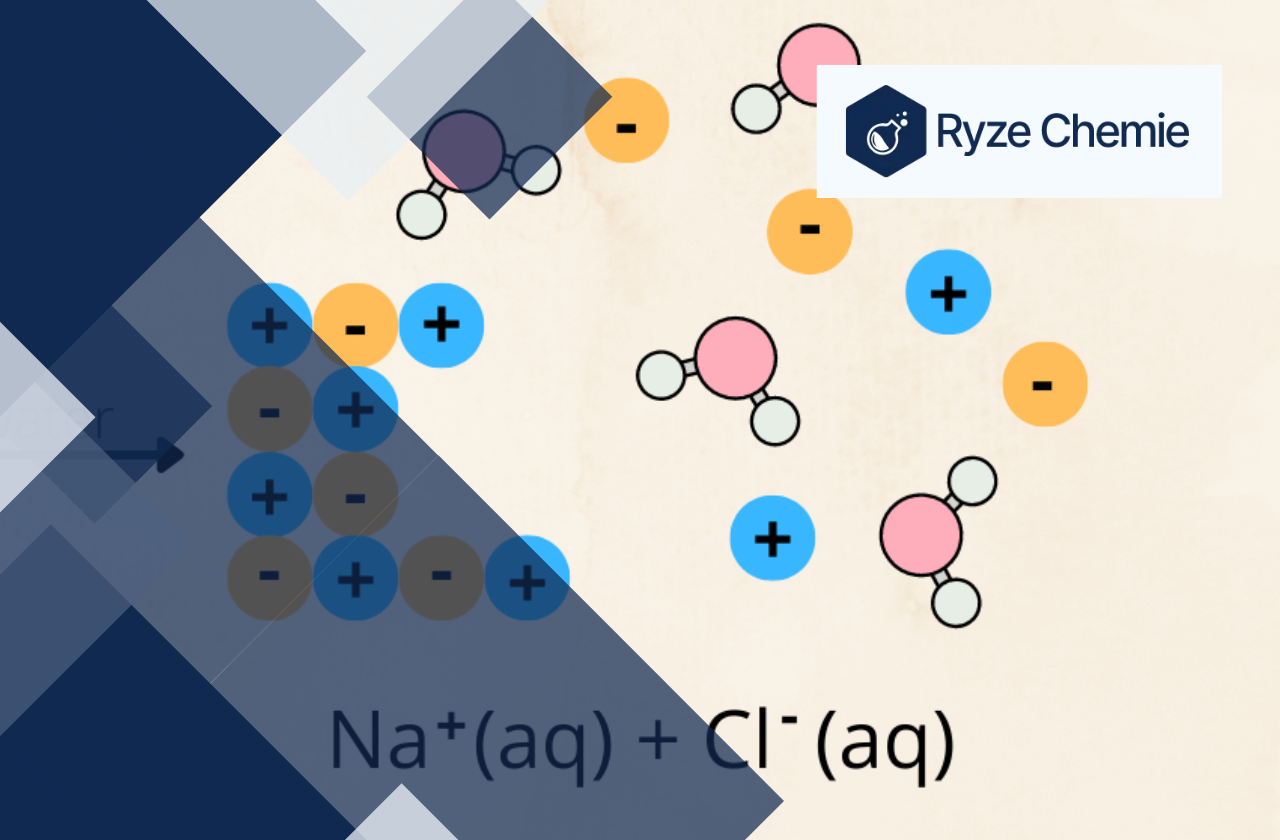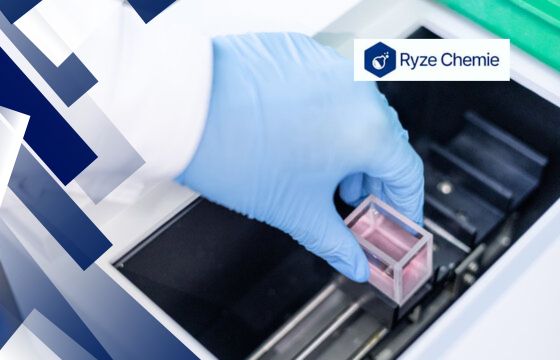
Stay up-to date on the
latest blogs. Join our
newsletter today!
This site is protected by reCAPTCHA and the Google Privacy Policy and Terms of Service apply.
How To Calculate Percent Dissociation? A Guide (2024)

Written by Team Ryze Chemie
9 mins read · Jun 18, 2024

Laboratory personnel often need to determine the extent to which a chemical compound dissociates or breaks apart in a solution. This is important for understanding the behavior of acids, bases, and salts in various chemical processes.
Accurately calculating percent dissociation can be a challenge, especially when dealing with complex compounds and varying concentrations.
This guide simplifies the process of calculating percent dissociation, providing step-by-step instructions and clear examples.
With this guide, you will gain the knowledge and confidence to calculate percent dissociation for different types of chemical compounds, enhancing your understanding of chemical reactions and their applications in the laboratory.
Fundamentals of Dissociation
Chemicals are made of smaller parts. Sometimes, these parts separate into liquids. We call this separation "dissociation."
Dissociation is a core concept in chemistry, especially for those working hands-on with chemicals in a laboratory setting. It is the process where compounds break down into smaller components, usually ions, when dissolved in a solvent. Let's break down the fundamentals of dissociation.
Types of Compounds That Dissociate
Acids:
Acids are substances that release hydrogen ions (H+) when dissolved in water. The degree of dissociation varies between acids:
- Strong Acids: These acids dissociate completely in water, meaning all their molecules break into ions. Examples include hydrochloric acid (HCl) and sulfuric acid (H2SO4).
- Weak Acids: These acids only partially dissociate in water, with some molecules remaining intact. Acetic acid (CH3COOH), found in vinegar, is a common example.
Bases:
Bases are compounds that release hydroxide ions (OH-) in water. Like acids, they also vary in strength:
- Strong Bases: These bases dissociate completely in water. Sodium hydroxide (NaOH) and potassium hydroxide (KOH) are examples.
- Weak Bases: These bases partially dissociate, with some molecules remaining whole. Ammonia (NH3) is a common weak base.
Salts:
Salts are formed from the reaction between an acid and a base. They dissociate completely in water, breaking down into their constituent ions. Sodium chloride (NaCl), or table salt, is a prime example.
The Equilibrium Constant (K)
Chemical reactions don't always go to completion. Many reactions reach a state of equilibrium, where the forward and reverse reactions occur at the same rate. This is where the equilibrium constant (K) comes into play.
Acid Dissociation Constant (Ka) and Base Dissociation Constant (Kb):
- Ka is the equilibrium constant for the dissociation of an acid. A larger Ka value indicates a stronger acid, as it means more of the acid molecules dissociate into ions.
- Kb is the equilibrium constant for the dissociation of a base. A larger Kb value indicates a stronger base, as it means more of the base molecules dissociate into ions.
Relationship Between K Values and Strength:
There's an inverse relationship between Ka and Kb for a conjugate acid-base pair. This means if an acid is strong (high Ka), its conjugate base is weak (low Kb), and vice versa.
Understanding dissociation and equilibrium constants is crucial for lab work. It helps predict how chemicals will behave in solutions and is essential for tasks like pH calculation, buffer preparation, and titration.
We now know how chemicals break apart. Next, let's learn how to calculate how much of the chemical separates.
Calculating Percent Dissociation
Percent dissociation (α) is a key measure of how much an acid or base breaks apart into ions in a solution. It's a simple calculation, but understanding the steps is crucial for accurate lab work.
General Formula
The percent dissociation is the amount of the acid or base that dissociates, divided by the initial amount, multiplied by 100%:
α = (Amount dissociated / Initial amount) x 100%
Step-by-Step Calculation for Acids
1) Balanced Chemical Equation: Start with the balanced equation for the acid's dissociation. For example, acetic acid (CH₃COOH) dissociates like this:
CH₃COOH ⇌ CH₃COO⁻ + H⁺
2) ICE Table: Create an ICE (Initial, Change, Equilibrium) table to track concentrations. Let "x" represent the change in concentration:
|
CH₃COOH |
CH₃COO⁻ |
H⁺ |
|
|
Initial (M) |
C |
0 |
0 |
|
Change (M) |
-x |
+x |
+x |
|
Equilibrium |
C-x |
x |
x |
(Where "C" is the initial concentration of the acid)
3) Ka Expression: The acid dissociation constant (Ka) relates the equilibrium concentrations. For acetic acid:
Ka = [CH₃COO⁻][H⁺] / [CH₃COOH]
Substitute the equilibrium concentrations from the ICE table and the known Ka value for the acid.
4) Solve for [H⁺]: The Ka value will likely be small. We often assume that "x" (the amount that dissociates) is much smaller than the initial concentration (C). This simplifies the equation, allowing us to solve for "x," which represents the [H⁺] concentration.
5) Amount Dissociated: The concentration of H⁺ ions ([H⁺]) you just calculated is equal to the amount of acid that dissociated.
6) Calculate α: Use the general formula to find the percent dissociation:
α = ([H⁺] / C) x 100%
Step-by-Step Calculation for Bases
The process is similar for bases:
- Use the base dissociation constant (Kb) instead of Ka.
- The ICE table tracks the concentration of OH⁻ ions instead of H⁺ ions.
- Solve for [OH⁻] using the Kb expression.
- Calculate α using the general formula, with [OH⁻] as the amount dissociated.
Simplifying Assumptions for Weak Acids and Bases
The assumption that "x" is small compared to the initial concentration is valid when the Ka or Kb value is small (typically less than 10⁻⁴). This means the acid or base is weak and only a small percentage dissociates. If the Ka or Kb is larger, you'll need to solve a quadratic equation, which is a bit more complex.
You can now calculate percent dissociation on paper. But, working in a lab is a bit different. Let's look at some tips for lab work.
Practical Considerations for Laboratory Work
Understanding how chemicals behave in solution is key to successful lab work. Here's a quick guide focusing on pH, dilution, and temperature – all important factors to consider when working with chemicals.
pH and How It Tells Us About Dissociation
The pH scale tells us how acidic or basic a solution is. But it can also give us clues about how much of a chemical has split apart into ions. This splitting is called dissociation.
- Strong Acids and Bases: These dissociate almost completely in water. Their pH will be very low (acidic) or very high (basic).
- Weak Acids and Bases: These only partly dissociate. To figure out how much, we use the Henderson-Hasselbalch equation. This equation is particularly helpful when working with buffers.
Buffers are special solutions that resist changes in pH. They are essential in many lab procedures and biological systems.
Dilution and Its Effect on Dissociation
When you add more solvent (like water) to a solution, you dilute it. Dilution affects weak acids and bases more than strong ones.
- Weak Acids and Bases: When diluted, they dissociate more. This means the pH will move closer to neutral (pH 7).
Temperature's Role in Dissociation
Dissociation reactions often depend on temperature. This means the pH of a solution can change if you heat it or cool it. It's always important to note the temperature at which you measure pH.
Measurement Techniques in the Lab
In the lab, we have several ways to figure out the concentration of a solution or determine its pH:
- Titration: A classic method where you carefully add one solution to another until a reaction is complete. This helps determine unknown concentrations.
- Spectroscopy: Using light to analyze a solution. Different chemicals absorb light at specific wavelengths, which helps identify and quantify them.
- pH Meter: A convenient electronic tool for direct pH measurement.
Lab work is one way to see this idea. Let's also look at some real-life examples to understand this better.
Examples of Percent Dissociation
Many common chemicals dissociate. Here are some examples to show how this idea works in real situations.
Key Equation
The formula for percent dissociation is: α = ([Ionized Form] / [Original Compound]) * 100%
Worked Examples
Example 1: Weak Acid (Acetic Acid)
Acetic acid (CH₃COOH) is a common weak acid found in vinegar. It partially dissociates in water: CH₃COOH ⇌ CH₃COO⁻ + H⁺
- Let's say we have a 0.10 M solution of acetic acid.
- The lab analysis shows that the concentration of H⁺ ions is 0.00134 M.
Calculation: α = (0.00134 M / 0.10 M) * 100% = 1.34%
This means only 1.34% of the acetic acid molecules have dissociated into ions.
Example 2: Weak Base (Ammonia)
Ammonia (NH₃) is a weak base used in cleaning products. It partially dissociates in water: NH₃ + H₂O ⇌ NH₄⁺ + OH⁻
- Suppose we have a 0.05 M solution of ammonia.
- The lab analysis reveals the concentration of OH⁻ ions is 0.00094 M.
Calculation: α = (0.00094 M / 0.05 M) * 100% = 1.88%
This means only 1.88% of the ammonia molecules have dissociated into ions.
Sample Lab Data and Calculations
Imagine you're analyzing a weak acid (HA) in the lab. Here's a simplified example:
|
Concentration (M) |
pH |
|
0.20 |
2.87 |
Steps:
- Find [H⁺]: Use the pH to find the concentration of H⁺ ions. In this case, [H⁺] = 10^(-2.87) = 0.00135 M
- Assume [A⁻] = [H⁺]: For weak acids, we can assume the concentration of the conjugate base (A⁻) is approximately equal to the concentration of H⁺ ions.
- Calculate α: α = (0.00135 M / 0.20 M) * 100% = 0.675%
Troubleshooting Tips
- Double-Check Units: Make sure all your concentrations are in the same units (usually molarity, M).
- Weak vs. Strong: Remember, percent dissociation is only relevant for weak acids and bases. Strong acids and bases dissociate nearly 100%.
- Approximations: For very weak acids and bases, we often make simplifying assumptions (like [A⁻] = [H⁺]). Be aware of these approximations and their limitations.
Conclusion
Calculating percent dissociation is crucial for understanding the behavior of weak acids and bases in solutions. It provides valuable insights into the extent of ionization and the concentration of ions present.
By mastering this calculation, laboratory personnel can accurately determine the strength of acids and bases, predict their reactivity, and optimize reaction conditions.
This knowledge is essential for various applications, including pH adjustments, buffer preparation, and chemical analysis. With practice and a thorough understanding of the underlying principles, calculating percent dissociation becomes a valuable tool in the chemist's toolbox.
Latest Blogs








